NPS Yorktown Battlefield Website; Local Yorktown Website; NPS Colonial NHP Website; Local Colonial NHP Website
WHAT IS IT?
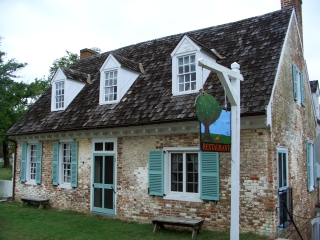 Site, in October of 1781, of the last major battle of the Revolutionary War and British General Cornwallis’ eventual surrender to George Washington’s Army.
Site, in October of 1781, of the last major battle of the Revolutionary War and British General Cornwallis’ eventual surrender to George Washington’s Army.BEAUTY (7/10)
Old Yorktown successfully combines a current residential area, complete with library and administrative buildings, with 18th century homes and structures, all of which is an easy walk from the Site’s Visitor Center.
Old Yorktown overlooks its namesake, the York River. While new riverfront homes and businesses look to be popping up quicker than Cornwallis’ case of the sniffles, the community has done a decent job at maintaining a colonial look and feel of properties adjacent to the NPS Site. They blend and extend the view, rather than disrupt it.
The driving tour of Yorktown Battlefield offers ample opportunities to photograph mounds of earth, white columnar monuments and fields of combat and surrender.
HISTORICAL INTEREST (9/10)
Yes Virginia, this is the place where we won the Revolutionary War. Sure, the Treaty of Paris was not signed until September of 1783 but Yorktown marked the end of the American-British fight, ensured our independence and, as the Park brochure boldly states, “significantly changed the course of world history”. It does not get much bigger than that.
In March 1781 at Guilford Courthouse (near present-day Greensboro, N.C.), General Cornwallis suffered a crushing victory. His army won the battle but lost over half its soldiers. The General was forced to retreat to Yorktown where he planned to regroup and wait for supplies. The help never came.
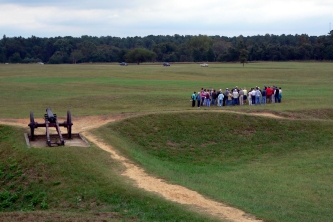 A fleet of French ships blockaded the entries into Yorktown, preventing any reinforcements. Meanwhile, George Washington’s Continental Army marched towards the entrenched Britons. The siege began on October 6. Around-the-clock bombardment continued until October 17, when Cornwallis had had enough.
A fleet of French ships blockaded the entries into Yorktown, preventing any reinforcements. Meanwhile, George Washington’s Continental Army marched towards the entrenched Britons. The siege began on October 6. Around-the-clock bombardment continued until October 17, when Cornwallis had had enough.Here comes the best part. Instead of admitting defeat and facing the triumphant rebels, the cowardly Cornwallis said he was sick and would be unable to surrender his army. In his stead, he sent his second in command. Haughty foolish Britons.
81 years later, Yorktown was the site of another military siege, this time during the American Civil War. Yorktown marked the landing site of Union General George McClellan’s mistake-riddled 1862 Peninsula campaign. Let us just say that it is a good thing McClellan was not in charge of the Continentals in 1781.
CROWDS (7/10)
The mild crowds at Yorktown paled in comparison to the pulsating masses found at Jamestown and Colonial Williamsburg. That is a good thing, but odd given Yorktown’s vital historical stature.
EASE OF USE/ACCESS (4/5)
Yorktown is easily accessible via I-64 Exit 247. Take Va. Route 238 the whole way to the Park Site. Signs will point you on your way. The 25-mile long Colonial Parkway connects Colonial NHP’s two major sections, Jamestown NHS and Yorktown Battlefield. The Parkway meanders amiably, allowing a stoplight and Interstate-free drive.
CONCESSIONS/BOOKSTORE (5/5)
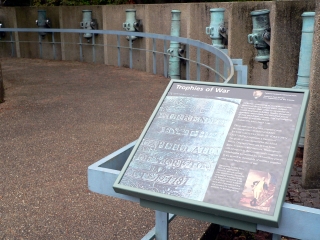 Independent concessionaires (antique shops and a restaurant) inhabit a few of the historic buildings that line Yorktown’s Main Street. The restaurant, Carrot Tree Kitchens, serves a terrific affordable lunch and boasts a hilarious menu. For example, the Admiral’s Crab Rarebit comes with this explanation: “The French Admiral only agreed to sail to Yorktown after he heard how good the crab was.”
Independent concessionaires (antique shops and a restaurant) inhabit a few of the historic buildings that line Yorktown’s Main Street. The restaurant, Carrot Tree Kitchens, serves a terrific affordable lunch and boasts a hilarious menu. For example, the Admiral’s Crab Rarebit comes with this explanation: “The French Admiral only agreed to sail to Yorktown after he heard how good the crab was.”COSTS (2/5)
Collectively, Yorktown Battlefield and Jamestown NHS are known as Colonial National Historical Park. The National Parks Pass (NPP) provides free entry into both Colonial NHP sites.
If you do not have the NPP, Yorktown Battlefield charges $5 per adult. Jamestown NHS charges $8 per adult. A combo pass is $10 per adult.
The Virginia State Park, Yorktown Victory Center, costs $8.25 per adult. The Commonwealth of Virginia also runs its own Park at Jamestown, called the Jamestown Settlement, which runs $11.75 per adult. Their combo pass is $17. The Yorktown Victory Center and Jamestown Settlement are not affiliated with the National Park Service; your NPP does not work there.
RANGER/GUIDE TO TOURIST RATIO (2/5)
Fore the most part, Colonial NHP seasonal hires and volunteers have replaced Rangers at Jamestown and Yorktown. Throughout the country, Rangers have effusively answered our questions regardless of building access restrictions and closing hours. However, at Yorktown, a teenage Polish girl refused to let us into the Georgian-style Nelson House ten minutes before closing time.
This is not a complaint because we understand workers wanting to go home. But it is undeniable that hired help and volunteers have distinctly different teaching priorities and educational prowess than salaried Federal employees.
We always see a consumer demand for Park Rangers. At Yorktown, the 3:30pm Ranger-led tour of the siege ground left the VC with 45+ people. We travel to these great historical locations to learn from professional educators, who, unfortunately, are no longer being hired. Park Rangers at Park Sites is not a given.
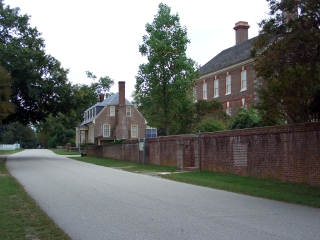 TOURS/CLASSES (6/10)
TOURS/CLASSES (6/10)The learning at Yorktown is visual, from the flashy 15-minute into film, to the replica ship located INSIDE the VC to historical artifacts used during the Siege at Yorktown. The tent George Washington used at Yorktown is usually on display here, but is currently on loan. Sad Michael. Sad Gab.
The same 18th Century Georgian buildings still line the streets of Old Yorktown. People still live and work here, unlike the reconstructed pseudo-historical constructions of the nearby Colonial Williamsburg. Yorktown does not feel like Disneyworld, it feels like colonial Virginia. Er…except for the luxury foreign automobiles that line the old houses’ driveways.
The two concise automobile tours of the siege grounds continue the visceral smorgasbord. Here you can see earthworks built by the British, the Continentals, the Union and the Confederacy. We took many pictures of the actual cannons surrendered by General Cornwallis that are perched adjacent to the field where the Recoats laid down their arms.
FUN (8/10)
Our first visit to Yorktown was late in the afternoon with just enough time to squeeze into one of the last showings of the introductory film. The tale of the American Revolution always puts us in a good mood. That mood carried us through the Visitor Center and out to Yorktown’s Main Street, where bare sidewalks were a welcome respite from the hustle and bustle of Colonial Williamsburg.
The catch: sidewalks were bare because most of the shops and concessions were closing. As you know, a resolute teen barred entrance to the Nelson House.
The next morning, we anchored our return visit with a wonderful brunch of Brunswick stew and Old Dominion biscuits at Yorktown’s Carrot Tree Kitchen. We hold fond memories of our time in Old Yorktown.
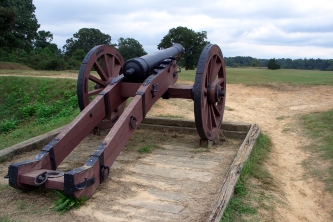 WOULD WE RECOMMEND? (7/10)
WOULD WE RECOMMEND? (7/10)Combine a trip to Yorktown Battlefield with a drive down the Colonial Parkway to Jamestown NHS; take a stroll through Colonial Williamsburg (free if you don’t enter any buildings!) and you have a near perfect low-cost weekend trip from just about anywhere in the mid-Atlantic region.
The area’s historical significance is easily digested through living history exhibits, Yorktown’s residential Main Street and eclectic Visitor Center. Visitors of any age can find something of interest along this colonial corridor.
TOTAL 56/80
www.usa-c2c.com
© 2004-06